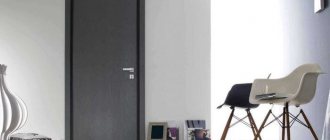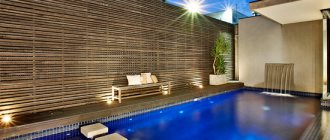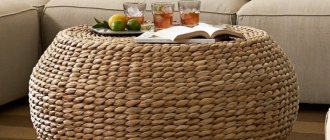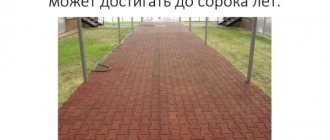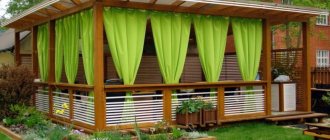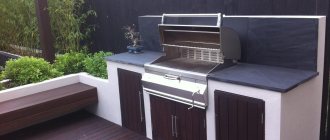Many people prefer to spend weekends in the summer at their dacha. Each of them faces the problem of recycling their waste products. Usually, out of old habit, they dig a cesspool and build a wooden structure. But now there is a more modern and environmentally friendly way - composting toilet for a summer residence. This is a device that purifies and processes waste into purified liquid, useful fertilizer or powder. Bioseptics are divided into two categories: portable, occupying little space and characterized by mobility, and stationary.
The type of dry closet depends on the method of waste treatment. Based on this, they distinguish:
- chemical,
- peat (composting),
- bacteriological,
- electric dry closets.
Chemical dry toilet
This dry closet model assumes the presence of two connected tanks. The upper compartment contains a toilet seat, like a regular toilet, and a water tank. And below there is a container for storing waste.
Toilets of this type differ in price, manufacturer or built-in functions. More expensive models are usually equipped with an electric flush pump and a collection part full indicator.
The principle of operation is simple: waste is drained with water, falling into the lower chamber. The chemical solution found there eliminates the unpleasant odor and converts the waste into liquid. The chemicals used are divided into formaldehyde and ammonium. The first should be used only if there is a chance of dumping waste nearby. The latter are completely non-toxic and decompose within one week.
Preparations made from live bacteria do not pose any danger. They can be reused as fertilizer.
Advice: When choosing a dry closet, you should decide in advance how often you will use it. For example, if one person uses a septic tank, then a tank with a minimum volume will fill in about a week. But it is better to purchase it with a tank with a capacity of 21 liters or more. Also pay attention to the possibility of replacing the pump and flush area. Find out about the maximum load, check for the presence of a fill indicator.
Liquid toilet
A liquid biotoilet is similar in structure to a peat toilet. It contains two tanks, the upper tank contains a deodorizing liquid for flushing, and the lower one contains a waste dissolving agent.
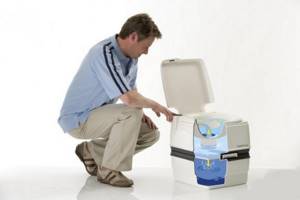
This type of plumbing uses three types of liquids:
Formaldehyde, toxic, red in color, allowed to be poured only into the sewer;
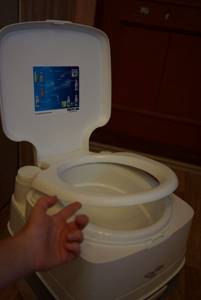
Ammonium, toxic, blue in color, dissolves waste in 5 minutes, can be thrown into compost, but not under fruit-bearing crops;
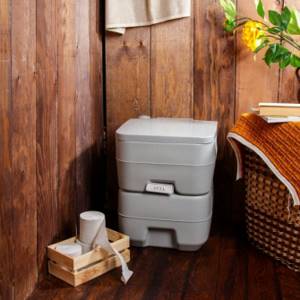
Biological, almost safe, colored green, it is permissible to dispose of them in a compost heap and leave them there for three years for complete recycling.

Peat (composting) dry closet
At first glance, a peat toilet resembles a chemical one, having two containers, but the upper chamber is filled not with water, but with peat. Excrement entering the receiving compartment is covered with a layer of peat. This subtype of septic tank performs two important tasks:
- without causing harm to humans and the environment, it destroys harmful microorganisms found in waste products,
- processes excrement into valuable fertilizer - compost.
The dry closet consists of a toilet seat and a receiving compartment, which creates special conditions for the proliferation of beneficial microorganisms.
Fillers such as peat, coconut fiber or wood shavings must be added to a composting toilet to control humidity. Ash or lime is added to dry peat septic tanks to destroy pathogens.
Tip: It is important to know that the time for complete decomposition of waste in warm climates is one year, and in places with cool weather conditions from two years.
Systems in toilets of this type are classified into active and passive. With the active method of decomposition of the contents, temperature regulators are used. In passive composting systems, processes occur without intervention. Also, peat dry toilets are divided into batch and continuous. In batch composting, when the receiving tank is filled, it changes. Continuous means that the waste is in it constantly.
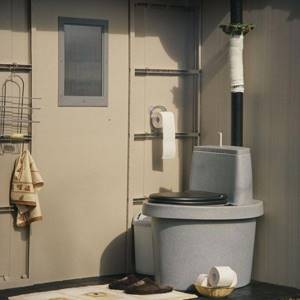
Depending on the design of the dry closet, there are:
- ready,
- homemade.
In finished toilets, waste accumulates in a composting unit attached to the toilet seat, located in another location, for example, underground or outdoors. There are different subtypes of such dry toilets - waterless, equipped with a microflush or a separate container for collecting urine. To build a bioseptic tank with your own hands, you don’t need much - a couple of boards, an ordinary iron bucket and a container of peat. The principle of operation of a septic tank is simple. The bag is put on the bucket and secured, and the seat is placed on top. A container with peat is placed nearby. And each new portion of excrement is sprinkled with it. After filling, the bag with waste is placed in the compost pit. Instead of peat, it is possible to use sawdust, but then composting takes a longer time.
Liquid (chemical) dry closet - device, pros, cons
This type of dry closet uses special liquids to process waste. The design has two containers into which the concentrate, diluted to a certain state, is poured. A liquid that processes waste is poured into the lower part, and a liquid with a deodorizing effect is poured into the upper part. Recycling liquids come in different types:
- Based on formaldehyde (red color). When using this type of liquid, waste should only be poured down the drain - it is toxic.
- With bioactive bacteria (green). This type of waste can even be placed in a compost heap, but it must be processed for a long time (at least three years). Method of using a liquid dry toilet
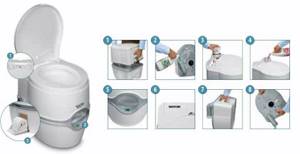
- Ammonium based (blue). Processing is fast - after 5-7 minutes there is only gray, odorless liquid in the container. You can put it in compost, but it is not advisable to use it to fertilize fruit and vegetable crops. Can be laid out on the lawn or under non-fruit trees and shrubs.
The device is operational only in the presence of the specified liquids. The rate of their consumption depends on the intensity of use. On average, refueling is required every 5-7 days.
Structure
The chemical toilet consists of several parts that are easily separated. The upper part is both the seat and the container into which the flavor is added. On the back right side of the lid of this compartment there is a pump start button, and on the left there is a hole for filling water.
What does a chemical (liquid) dry closet consist of?

The processing concentrate diluted with water is poured into the lower reservoir. At the very bottom there is a waste collection box. The capacity of this tank is from 12 to 24 liters. To be able to monitor the filling level of this tank, there are models with a fill indicator. As it fills, the color changes from green to red. In those tanks where there is no such indicator, a strip of transparent plastic is often built in. So that you can visually monitor the level of waste.
Disassembled
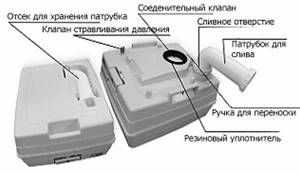
All parts are connected to each other with special locks that securely fix them in place. To make it easier to remove waste, a handle is attached to the bottom container. There is a pipe for draining waste into a container. It is screwed to the inlet hole if necessary. In general, it is stored in a specially designated place.
Some models have a built-in pressure valve in the poop reservoir. It is needed to make emptying the container easier. But there is one drawback to this - there are times when leaks begin at the place where this valve is attached. Then you can’t carry the container by the handle; you have to carry it in front of you on your hands. Completely inconvenient.
The flush pump can be manual or electric. When using electric, there is no way to regulate the amount of water supplied - it is always the same. This causes the tank to fill faster. The device runs on batteries, which need to be changed periodically.
Types of pumps for liquid dry closets
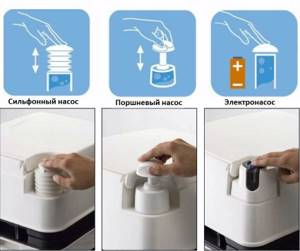
Hand pumps come in bellows and piston types. By pressing the piston with different force, you can regulate the amount of water supplied.
Preparation for work and operation
Operating a liquid dry closet is not difficult, but requires constant attention. It is necessary to monitor the presence of liquid and the fill level of the waste tank. We have to remove and dispose of waste quite often. A 12-liter capacity for 2-3 people is filled in 2-3 days. If there are more people, you have to carry them out every other day, and sometimes every day. Not very convenient, although much more convenient than using a bucket.
Disassembled liquid toilet
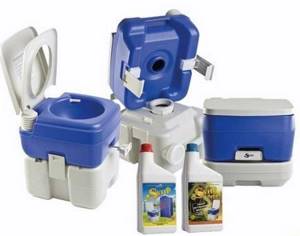
The procedure for preparing a liquid dry closet for operation is as follows:
- By pressing the button, detach the upper part.
- Pour the appropriate solution into containers.
- Place the containers in place and secure them with a lock.
That's it, the dry closet is ready for use. After each use it must be washed off. The portion of liquid is small, but it is enough to clean the drain. The mechanism is as follows: use the toilet for its intended purpose, open the valve, waste falls into a container with processing liquid. Rinse off with water and fragrance, using a brush if necessary. Close the valve. To ensure that there is no smell at all from a liquid dry toilet, you need to make sure that there is always a certain amount of liquid on the valve (about 1 cm thick). This liquid works like a water lock, cutting off possible aromas.
To make it easier to remove waste, the container should have wheels
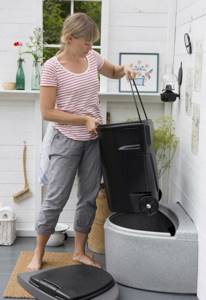
After each emptying, you need to wash the container, pouring a new portion, you need to loosen it to wash all the walls. After this, processing will proceed more fully.
This dry toilet for the dacha is a mobile option. It fits in the trunk of a car, which is convenient. There is, however, an unpleasant point: if the dacha is visited periodically, it is impossible to leave a tank with liquid in an unheated room. If frozen, it can damage the walls. Some people add non-toxic antifreeze (polypropylene glycol) to the recycling liquid for the winter. Bacteria are unlikely to survive in such an environment, but the yield for ammonium and formaldehyde is not bad. Only such waste must be disposed of in the sewer.
Advantages and disadvantages
This dry toilet for the dacha is attractive because it does not require permanent installation. It can work anywhere, immediately after filling with liquids. Nothing else is needed for it to work.
Disadvantages - the need to refuel, although it’s not very big, it’s still money. It is also necessary to ensure that there is a certain supply of concentrates - without them (especially without the one that is poured downwards), the dry closet turns into an ordinary bucket with a lid.
But the most annoying thing is the need to frequently empty the waste container. In any weather, at any time, if the tank is almost full, it has to be emptied. Otherwise you can't use the toilet. As a temporary option, this is an excellent choice.
Popular manufacturers
The most popular are Dutch liquid (chemical) dry closets from Thetford. They are produced under the name Porta, there are models with varying degrees of comfort, with noticeably different prices.
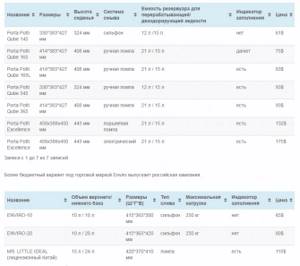
Electric dry closet.
These toilets operate using electricity and look like a regular toilet. When installing such a septic tank in a country house, ventilation will be required. Electricity consumption is not high, about the same as a standard light bulb.
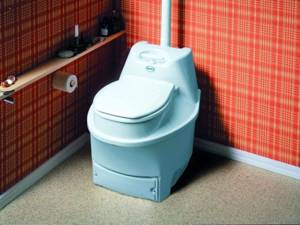
This type of toilet is characterized by waste separation. Liquids will be discharged through a hose into a previously prepared sewer, and solids will be dried by a compressor to powder and stored in the lower compartment.
Advantages and disadvantages of bioseptics.
When choosing a dry closet, you should be guided not only by price, but by the degree of convenience and the possibility of installing it in your summer cottage. Peat toilets eliminate the need for waste disposal, and they make an excellent fertilizer - compost. Septic tanks of this type are characterized by low energy consumption and a smaller volume of the tank into which excrement is collected. The only inconvenience is the frequency of toilet maintenance, because the fertilizer will be ready for use only after at least a year and it needs to be stored somewhere. If errors were made during installation, then there is a possibility of unpleasant odors and a low-quality final product. There are devices of this type that require connection to a power source for heating or ventilation.
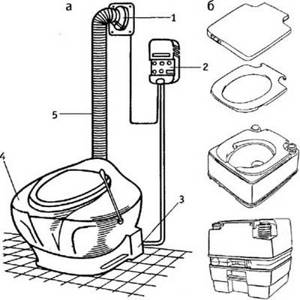
Chemical dry toilets are lightweight, take up little room space, and fully guarantee hygiene and odorlessness. But they are very expensive, since you need to constantly spend money on chemicals.
Electric toilets are absolutely similar to apartment toilets, have an easy cleaning system and eliminate unpleasant odors. In terms of cost, they are the most expensive, and also require ventilation, sewerage and electricity.
What to look for when choosing a toilet?
All dry closets have different principles of operation, which must be taken into account when choosing. The average consumer, who is puzzled by equipping his country bathroom, begins to study the issue with a photo of a dry closet for his dacha.
When it comes to familiarizing yourself with the device, it is important to consider the following points:
- Dimensions and ergonomics;
- Capacity;
- Material of the body and other elements;
- What substance is used for disposal;
- Environmentally friendly to use;
- The installation is stationary or mobile.

If children will use the toilet, then you need to pay attention to the height of the toilet seat. The weight of the largest toilet user should also be taken into account and based on this parameter when choosing a toilet. A big plus is the presence of a waste container full indicator.
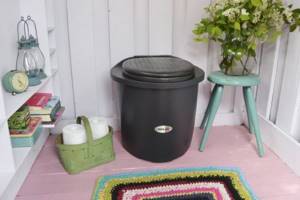
To understand how to choose a toilet, you need to evaluate the conditions in which it will be placed.
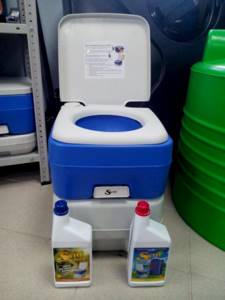
Problems that arise when using a dry closet.
Using a bioseptic tank brings comfort and convenience to your dacha. This technology is new and many people are not familiar with it enough. It is important to have all the information about the operation and rules of using a dry closet. Often waste is biodegraded using living bacteria. Do not flush toxic or antibacterial substances into the toilet, or throw cigarette butts or rubber.
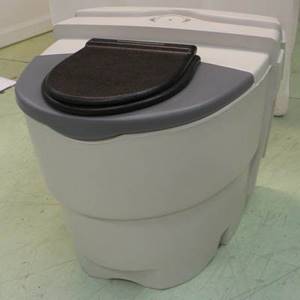
Let's figure out what can happen if you throw everything into a septic tank indiscriminately.
- pipes will become clogged and filters will become clogged
- beneficial bacteria will die
- there will be difficulties with cleaning
The problem of blockages and stagnation should be solved at the installation stage. Pipes need to be chosen in a large size and set at the correct angle of inclination from the house to the septic tank. The following two problems can be easily solved using special paper for bioseptics. Compared to regular paper, it costs an order of magnitude higher, but repairing a toilet will reduce all the resulting savings to zero.
Tip: To avoid blockages, try to use easily dissolving paper; do not throw lumps of paper into the septic tank. Also, newspapers and various types of garbage cannot be disposed of. Since synthetics can harm bacteria, it is recommended to choose the right detergent.
Peat dry toilets for summer cottages
Externally, a peat dry closet resembles a regular toilet. The only difference is that instead of the usual “leg” that hides the siphon and sewer outlet, under the toilet bowl there is a sealed tank in which waste products are mixed with peat. The latter enters the toilet from the “flush” tank or is loaded into the container manually (the most primitive models). In addition to peat toilets, there are also sawdust toilets. They work on the same principle, but instead of peat they use sawdust. When the lower tank is filled, the fully or partially processed substrate is taken out into the compost and spilled with EM preparations (Baikal EM1, Siyanie, Ecoberin, etc.).
The advantages of peat dry toilets: comparatively cheap, high environmental safety, ease of operation, long intervals between cleaning procedures, budget consumables, the ability to use for composting, a wide choice of models not only depending on the appearance, but also the volume of the waste tank.
Disadvantages of peat dry toilets: presence of odor (this problem is solved in expensive models), difficult to install in the house, low mobility, requires ventilation equipment (mandatory) and drainage (for frequent use), poorly suited for use in winter, since the temperature is lower 10°C bacterial activity slows down or stops completely.
Who is it suitable for? For summer residents who need to install a permanent toilet in an area without sewerage and for those who rarely visit their country house during the cold season. It will help solve the problem with the toilet in an area that is not yet developed.
Using a composting toilet in the winter cold.
Lovers of country holidays, residents of villages and villages want to use a septic tank in the winter months. It's possible. The main thing is to take into account the peculiarities of the toilet’s operation in cold weather. Sellers deceive, claiming that dry toilets perform all functions no worse in winter than in summer. This is possible only for areas where the temperature does not drop below zero.

What can be done to make the toilet frost-resistant? During construction, the waste tank should be buried to a depth of at least a meter and the pipeline should be laid at the correct angle. In this case, nothing will freeze, since the heat generated by the bacteria will be sufficient. In severe frosts, it is recommended to service the toilet more often.
To prevent the tank from freezing, antifreeze or a special liquid is added to the water, which also eliminates unpleasant odors.
If the septic tank is not used in winter, it must be removed before the onset of warm weather. It is worth introducing special bacteria into the septic tank system two weeks in advance for cleaning. Then remove all residues from the waste storage container. In order to eliminate foreign odors, it is recommended to leave a few liters of water in the system.
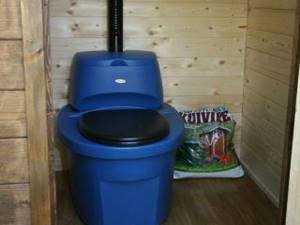
An insulated dry closet is essential in winter. The best option is to purchase or build a heated septic tank yourself. The installation of such a septic tank will cost much more. But the price is not commensurate with the benefits received: protection from weather influences, warmth and convenience. In such buildings, the walls of the toilet cubicle are insulated, and the waste collection tank is equipped with an electric thermal heater. The warm tank is made multi-level; heat-preserving materials are placed in the gaps. A dry closet for winter use has one non-critical drawback - without electricity it will not function properly, but lighting the cabin at night will not be amiss.
The main thing to remember is that the effort spent on equipping a winter toilet will be fully repaid with irreplaceable comfort.
Types of dry toilets
Based on your needs and wishes, you can inexpensively order any country dry toilet you like. What are they?
1. Liquid . Very easy to use, easy to carry, does not take up much space. To decompose waste, a special liquid , which is mixed with water. It breaks down solid waste and turns it into liquid. Before purchasing, study the volumes of the lower tanks of such dry closets. The larger it is, the less often it will need to be cleaned. The waste mass is drained into a drainage pit or used as fertilizer for beds, but for this you need to use environmentally friendly liquids. When using cheap fillers, waste must be disposed of through the sewer system. The leading brand in the liquid dry toilet market is Thetford . We recommend products from a Dutch company that has been producing portable dry toilets for over 40 years. The main distinguishing features of Thetford products are the best price-quality . These dry closets are time-tested and have unsurpassed reliability.
2. Peat . They are also called dry or Finnish dry toilets. The operating principle is very simple. Feces in the storage tank are sprinkled with peat , and liquid waste is discharged into the sewer or waste pit. The tank of such toilets must be emptied systematically. If you like to plant plants or grow flowers, such a toilet will bring additional benefits. Since the waste in it is mixed with peat, it makes an excellent compost fertilizer for your beds. It is important to add sawdust to the peat. This way the waste will be processed much faster and more efficiently. Keep in mind that for 10 kg of waste you will need approximately 1 kg of filler mixture. We recommend models from Piteco . The company has been producing and selling peat dry toilets for more than 15 years. These are the most reliable and durable designs, which, despite their highest quality, have a very low price .
Our company presents various dry closets, with a detailed review, photos and descriptions of which you can find on the website of our online store or call us for a detailed consultation.
